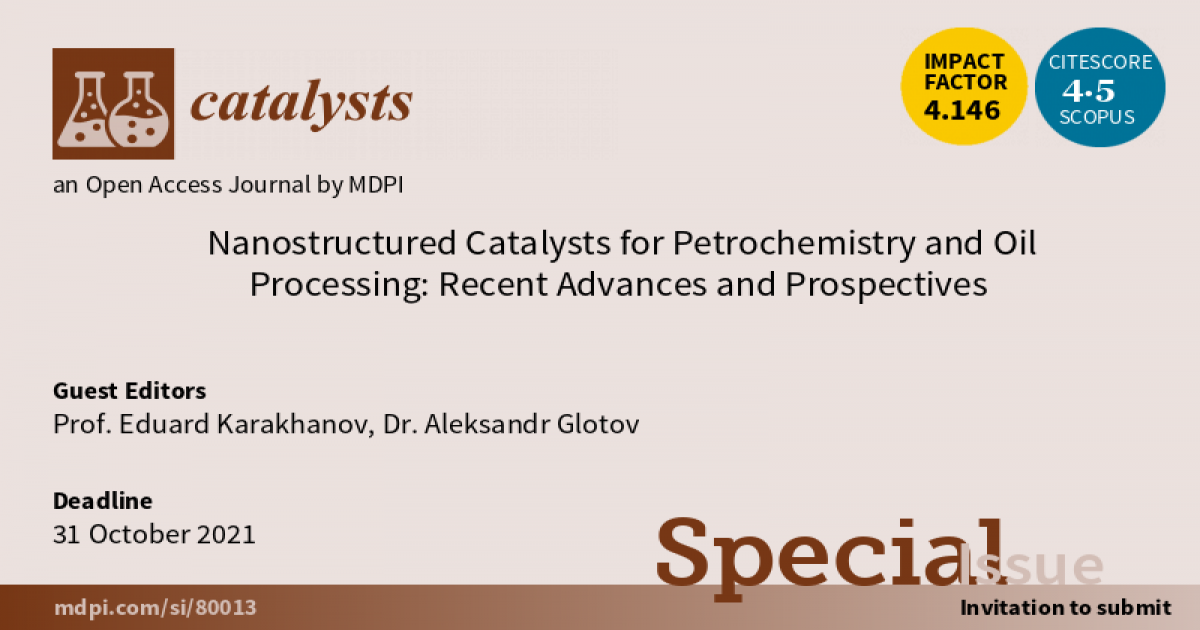Nanostructured Catalysts for Petrochemistry and Oil Processing: Recent Advances and Prospectives
A special issue of Catalysts (ISSN 2073-4344). This special issue belongs to the section "Environmental Catalysis".
Deadline for manuscript submissions: closed (31 October 2021) | Viewed by 7612

Special Issue Editors
Interests: petroleum chemistry; heterogeneous catalysis; oil refining; metal–organic frameworks; dendrimers; zeolites; structured mesoporous aluminosilicates; hydroformylation
Special Issues, Collections and Topics in MDPI journals
Interests: aluminosilicate nanotubes; zeolites; nanostructured mesoporous materials; aluminosilicate nanomaterials; catalytic cracking; hydroprocessing; isomerization
Special Issues, Collections and Topics in MDPI journals
Special Issue Information
Dear Colleague,
With the recent advent of nanotechnology, the design of catalysts based on nanostructured materials is of great interest. Novel techniques are being developed by engineers and researchers to create, characterize, and evaluate nanostructured catalysts for a wide range of applications, including conventional processes of oil refining and petrochemistry. The catalysis community is faced with challenges for new process development, and this research area could be significantly boosted by nanostructured catalysts with tuned properties, e.g., structure, surface morphology, active sites, acidity, etc. Keeping pace with progress, the researchers have to look back, critically assessing current knowledge and pondering future developments.
This Special Issue aims to cover the most recent advances in the field of synthesis, characterization, and evaluation of catalytic properties of nanostructured materials for petrochemistry and oil processing. This includes, but is not limited to, hydroprocessing (including hydrotreating, isomerization, reforming, selective hydrogenation), renewables processing, catalytic cracking, C-1 chemistry, hydroformylation, valuable chemicals synthesis, and photocatalysis.
Prof. Eduard Karakhanov
Dr. Aleksandr Glotov
Guest Editors
Manuscript Submission Information
Manuscripts should be submitted online at www.mdpi.com by registering and logging in to this website. Once you are registered, click here to go to the submission form. Manuscripts can be submitted until the deadline. All submissions that pass pre-check are peer-reviewed. Accepted papers will be published continuously in the journal (as soon as accepted) and will be listed together on the special issue website. Research articles, review articles as well as short communications are invited. For planned papers, a title and short abstract (about 100 words) can be sent to the Editorial Office for announcement on this website.
Submitted manuscripts should not have been published previously, nor be under consideration for publication elsewhere (except conference proceedings papers). All manuscripts are thoroughly refereed through a single-blind peer-review process. A guide for authors and other relevant information for submission of manuscripts is available on the Instructions for Authors page. Catalysts is an international peer-reviewed open access monthly journal published by MDPI.
Please visit the Instructions for Authors page before submitting a manuscript. The Article Processing Charge (APC) for publication in this open access journal is 2700 CHF (Swiss Francs). Submitted papers should be well formatted and use good English. Authors may use MDPI's English editing service prior to publication or during author revisions.
Keywords
- nanostructured materials
- petrochemistry
- oil refining
- zeolites
- hierarchical systems
- aluminosilicates
- organiс and metal–organic frameworks
- nanotubes
- hydroprocessing
- C-1 chemistry






